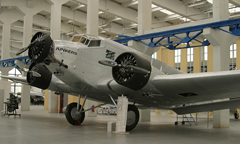The Technikmuseum Hugo Junkers is located in Dessau, Germany, and is dedicated to the life and work of Hugo Junkers, one of the most influential figures in the development of aviation and engineering in the early 20th century. Junkers was a pioneering German engineer, aircraft designer, and founder of the Junkers Aircraft Company, which played a critical role in the evolution of both aviation and aircraft design. The museum honors his legacy by showcasing a variety of his innovations in aviation, materials science, and engineering.
Technikmuseum Hugo Junkers
Kühnauer Straße 161a
06846 Dessau
https://technikmuseum-dessau.org/
+49 340 661 19 82
March – October
- Daily 10:00 – 17:00
November – February
- Monday – Sunday 09:00 – 16:00
Admission fee
Gift shop

Aircraft collection

| D-FWJD
DM-SAF – – 6134/1Z+BY D-HZPT DM-2052 16 258 585 D-HZPE D-0280 75+26 25+09 127 D-8245 77 D-ESMX | Antonov An-2
Ilyushin Il-14 Junkers F13 (replica) Junkers J1 (replica) Junkers Ju52/3mg4e Kamov Ka-26 Lommatzsch Meise Mikoyan Gurevich MiG-15UTI Mikoyan Gurevich MiG-21U-400 Mikoyan Gurevich MiG-23MF PZL-Swidnick Mil Mi-2 Spaltz A Sud Aviation SE3130 Alouette II* Sukhoi Su-22M-4 Sukhoi Su-22UM-3K SZD-9bis Bocian Yakolev Yak-27R Zlin Z-37 Cmelak |
The highlight of the Technikmuseum Hugo Junkers is a restored Junkers Ju 52/3m, which sank in 1940 during World War II in Hartvikvatnet near Narvik in Norway. It was lifted again in 1986 and returned to Dessau in 1995. In exchange a MiG-21PFM (clock number: NVA 891 / Bw 22+37) was delivered to Norway. Today this aircraft belongs to the “Norwegian Armed Forces Museum / Forsvarsmuseet” in Oslo and is not exhibited at the moment.
Outside the hall, further exhibits can be seen, including the remains of a wind tunnel from 1934, a compensation station for adjusting the on-board instruments from 1935, a passenger aircraft of type Il-14 from Dresden and refrigerated wagons from the Dessau wagon construction company. In addition, several civil and military aircraft and a police helicopter from the former GDR can be seen on the outdoor grounds.
The machines exhibited in the outdoor area are in urgent need of restoration, except for the Il-14.
All aircraft and helicopters on display have been taken over from the stock of the air sports department of the police sports club “PSV 90 e.V. Dessau”, which was dissolved in 2000.
Key Features of the Technikmuseum Hugo Junkers:
- Celebrating Hugo Junkers:
- Hugo Junkers (1859–1935) was a German engineer, inventor, and aviation pioneer known for his groundbreaking work in the development of aircraft design and the use of metal in aviation.
- Junkers’ most significant contribution was the design of the Junkers J 1, the world’s first all-metal aircraft, which helped revolutionize aviation by demonstrating that metal could be used instead of wood and fabric for constructing airframes. This innovation laid the foundation for modern aircraft design.
- Aircraft Collection:
- The Technikmuseum Hugo Junkers houses several historical aircraft, including replicas and models of Junkers’ most famous planes, such as the Junkers J 1, Junkers F13, and Junkers Ju 52, one of the most iconic aircraft of the 1930s.
- The Junkers F13 was one of the first all-metal commercial aircraft, marking a significant advancement in aviation technology. The museum showcases models of this aircraft along with explanations of its technical and historical importance.
- Innovations in Aircraft Design:
- The museum delves into Junkers’ technological innovations, including his contributions to metal construction for aircraft, engine development, and aerodynamics. His designs were some of the first to use monocoque construction (a method in which the outer shell bears the load) in aviation, a technique that would later become standard in modern aircraft design.
- It explains how Junkers’ innovative approach to metal fuselages, which were previously thought to be too heavy or impractical, revolutionized the way planes were built and paved the way for more durable and reliable aircraft.
- Aircraft Engines and Propulsion:
- The Technikmuseum Hugo Junkers also displays models and components of aircraft engines designed by Junkers and his company. These engines played a critical role in improving the performance and reliability of early aircraft.
- The museum provides insight into engine development during the early 20th century, particularly the Junkers Jumo engines, which were widely used in military aircraft during World War II.
- Junkers’ Contribution to Civil Aviation:
- In addition to his military innovations, Junkers was a key figure in the development of civil aviation. His Junkers Ju 52 aircraft, often called the “Tante Ju” (Aunt Ju), was used extensively by airlines, freight carriers, and the military during the 1930s and 1940s.
- The museum displays models and parts from these aircraft, explaining their role in shaping the development of air transport and their influence on both commercial and military aviation.
- Materials and Engineering Innovations:
- Hugo Junkers was also a leading figure in the field of materials science. He made significant contributions to the development of lightweight metal alloys and durable materials, which were vital not only in aviation but also in other industries.
- The museum highlights his work in developing the first all-metal airplane, explaining how the use of metal allowed for stronger, more efficient aircraft that could withstand the stresses of flight better than earlier wooden or fabric-based planes.
- Technological Exhibits and Educational Programs:
- The Technikmuseum Hugo Junkers offers a range of educational exhibits that provide a detailed look at the engineering and technological advancements of Junkers’ work. Visitors can explore models of aircraft, engines, and materials, along with detailed descriptions of how these innovations were applied in aviation.
- The museum also provides interactive displays where visitors can learn about the principles of flight mechanics, aerodynamics, and aircraft construction.
- The Role of the Junkers Company:
- The museum explores the history of the Junkers Aircraft Company, founded by Hugo Junkers, and its pivotal role in both civilian and military aviation. The company was a leader in aircraft manufacturing during the pre-World War II era and continued to have an impact on the development of aviation technology in the decades that followed.
- The museum displays artifacts, photographs, and documents that trace the evolution of the Junkers company and its aircraft designs, as well as its influence on global aviation.
- Architectural Features of the Museum:
- The Technikmuseum Hugo Junkers is housed in the historic Junkers Factory, where many of Hugo Junkers’ early designs were created. The architecture of the building itself is a testament to early 20th-century industrial design, with the museum preserving the legacy of the Junkers factory and showcasing how the facility contributed to the development of aviation technology.
- Location and Visitor Experience:
- The Technikmuseum Hugo Junkers is located in Dessau, in Saxony-Anhalt, Germany, a region historically significant for its association with the Bauhaus movement and aviation history.
- Visitors can explore the museum’s collection of aircraft models, engine parts, historic documents, and blueprints, gaining a deeper understanding of Hugo Junkers’ visionary contributions to aviation and engineering.
Summary:
The Technikmuseum Hugo Junkers in Dessau is a fascinating museum dedicated to the life and innovations of Hugo Junkers, a pioneer of aviation engineering. The museum showcases a wide variety of aircraft and aviation-related technologies developed by Junkers and his company, particularly focusing on his groundbreaking work with all-metal aircraft. With its extensive collection of historical aircraft, engine models, and technological innovations, the museum offers a comprehensive look at the evolution of aviation during the early 20th century. Whether you’re an aviation enthusiast, a history buff, or simply curious about one of aviation’s most influential figures, the Technikmuseum Hugo Junkers provides a fascinating and educational experience.
